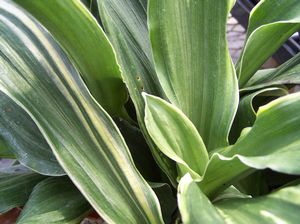View All Plants :: View All BULBS :: View All SHADE PERENNIALS
Rohdea japonica 'Talbot Manor'
Sacred Lily
Plant Type:
BULBSRohdea japonica ‘Talbot Manor’ – (These are bursting out of trade gallons (approx. 2-qt., worth every penny) White striations placed irregularly from base to tip on the dark green leathery strap-shaped leaves decorate this Sacred Lily. Often, leaves are also edged in white. Foliage is also somewhat distorted with broad undulations and are more rounded than pointy at the tips. A very popular item in Japan they are painfully slow to size up into colonies; this jacks prices to exorbitant levels, especially any among the variegated cultivars which are highly prized by the Japanese. Flowers are like squat, fat little corn cobs composed of tightly clustered light yellow-green florets. They open to reveal anthers, the edges of the orifice like little teeth surrounding the central pistil. Pollinated florets develop clustered red “berries” loosely resembling the fruiting inflorescence of Jack-in-the-Pulpit. Site in fertile to draining woodland soils. All Sacred Lilies are tolerant of dry summer soil. Plant ‘Talbot Manor’ in shade. Be sure to check availability before ordering. Order early – it is likely we will ever have but few available and perhaps not in every year. Sacred Lily clumps with slow increase. Spring planting is strongly advised in the northern range - please wait. Shelter in the northern fringes. Established pot grown division.
Characteristics and Attributes for Rohdea japonica 'Talbot Manor'
Season of Interest (Flowering)
- Spring
Season of Interest (Foliage)
- Four Seasons
Autumn Interest
- Fruit / Berries / Seed Heads
Nature Attraction
- Deer Resistant
Light
- Morning Sun / Afternoon Shade
- Dappled Shade
- Shade
Attributes
- Potted Plant
- Drought Tolerant
- Woodland
- Rock Garden
- Specimen
Growth Rate in the Garden
- Slow
Soil
- Fertile
- Draining
Origins
- Garden Origin
Propagated By
- Division


